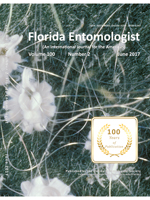Fruit flies (Diptera: Tephritidae) are considered to be one of the principal groups of pests in fruit culture worldwide. The objective of this study was to investigate oviposition by Anastrepha fraterculus (Wiedemann) and Ceratitis capitata (Wiedemann) in citrus fruits and to assess the development of these species in relation to the maturity of orange fruits. The experiments were carried out under controlled temperature conditions (25 ± 2 °C), RH (70 ± 10%), and photoperiod (12:12 h L:D). Oviposition was evaluated by exposure (with and without choice) to fruits of ‘Navelina’orange [Citrus sinensis (L.) Osbeck], ‘Clemenules’ tangerine (C. reticulata Blanco), and ‘Siciliano’ lemon [C. limon (L.)] (Rutaceae). Insect development was studied on Navelina orange at 4 stages of maturity (I: 5 cm in diameter, II: 6 to 7 cm in diameter, III: skin with color change, and IV: yellow-orange skin). We evaluated oviposition by counting the number of eggs, and we assessed biological parameters of the immature and adult stages. The number of eggs deposited in orange and tangerine by both fruit fly species did not differ significantly, and oviposition did not occur in lemon. Anastrepha fraterculus preferred to oviposit in tangerine fruits, whereas C. capitata showed preference for orange fruits. Development from egg to adult by A. fraterculus and C. capitata occurred only in stage IV oranges, and required 30.9 and 31.0 d, respectively. Females of A. fraterculus and C. capitata developing in mature orange fruits produced a mean of 378.7 and 183.5 eggs, respectively.
How to translate text using browser tools
1 June 2017
Oviposition of Anastrepha fraterculus and Ceratitis capitata (Diptera: Tephritidae) in Citrus Fruits, and Development in Relation to Maturity of Orange Fruits
Naymã P. Dias,
Sabrina Ongaratto,
Mauro S. Garcia,
Dori E. Nava

Florida Entomologist
Vol. 100 • No. 2
June 2017
Vol. 100 • No. 2
June 2017
biologia de moscas-das-frutas
citrus
fruit fly biology
Mediterranean fruit fly
mosca-das-frutas sul-americana
mosca-do-mediterrâneo
South American fruit fly




